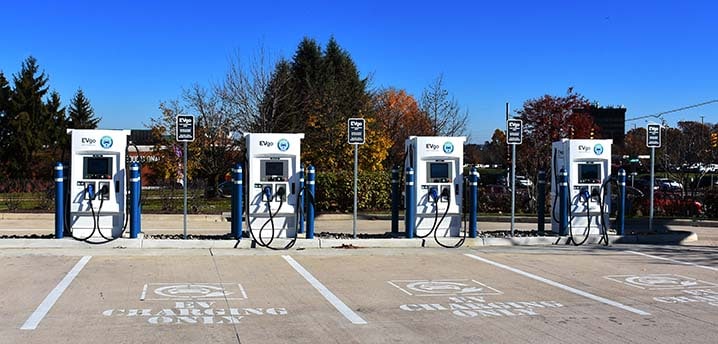You’ll be surprised at how easy it is to find an EV charging station wherever the road takes you.
Electrification continues to take our roads by storm thanks to its unrivaled efficiency, smooth ride characteristics, and exhilarating performance. Whether you already own an electric vehicle or are looking to make your first purchase, you might be curious about how conveniently you can find a charging station.
Even with a charging outlet at home, you want to look out for spots to stop and have a quick battery top-up when you’re on the road. According to Statista, the current EV infrastructure network in the U.S. comprises over 46,000 public charging stations and more than 113,000 charging outlets. The flip side of this good news is that the infrastructure is unevenly distributed across the country. California has nearly the same number of charging stations as the 39 states with the lowest count combined.
So, what happens when you’re taking a road trip? Range anxiety will certainly kick in as you constantly monitor your battery level. Not that bummer again. Luckily, we’ve outlined everything you need to know to help you find electric vehicle charging stations. You’ll soon discover how easy it is to find a plug-in spot for some extra juice.
The Basics of EV Charging Infrastructure
Consumers and large fleets who own or are considering all-electric or plug-in hybrid vehicles need access to charging stations. Most drivers start with at-home charging but there’s a growing acceptance of charging stations at workplaces and public areas.
Electric charging infrastructure largely aligns with an industry standard known as the Open Charge Point Interface (OCPI) protocol, which automates roaming for drivers across charging networks. The protocol also adopts common charging infrastructure terminology as follows:
- Station location: This is a site with one or more electrical vehicle supply equipment (EVSE) ports, such as a mall parking lot.
- EVSE Port: An ESVE port is the source of power to charge a vehicle at a time, and may have multiple connectors.
- Connector: A connector is what you plug in your vehicle to charge it. Multiple connector types can be available, including CCS and CHAdeMO, as we’ll discuss later.
Electric vehicle charging equipment is classified by the rate at which it fills up your battery. The type of battery, its energy capacity, how depleted it is, and the type of charging equipment may affect charging times. Charging times could range from less than 20 minutes to over 20 hours.
Here are the three types of EV charging equipment.
Level 1 Charging
Level 1 equipment charges your electric vehicle through a 120 Volt AC plug, usually the standard home charger outlet. It restores 2 to 5 miles of range per hour of charging. Most plug-in electric vehicles have a manufacturer-available cordset, so you don’t need any additional charging equipment. One end has a standard NEMA connector while the other has an SAE J1772 connector. The J1772 plugs into your car while the NEMA connector plugs into the power outlet.
Important note: Tesla vehicles come with a J1772 adapter that lets them use non-Tesla charging equipment.
Level 2 Charging
Level 2 charging equipment charges through 240 V or 280 V power outlets typically available in residential and commercial areas. It replenishes 10 to 20 miles of range per hour of charging. The charging system shares the J1772 connector as the Level 1 equipment. As a result, all commercially available EVs can charge using Level 1 and Level 2 equipment.
Direct Current (DC) Fast Charging
Direct current (DC) fast charging equipment uses a 208/480 V three-phase input for rapid charging. It fills up 60 to 80 miles of range per 20 minutes of charging. Three DC fast charging systems are available depending on the port on the vehicle:
- CCS (Combined Charging System): Also known as the J1772 combo, the CCS connector lets you use the same port with Level 1, Level 2, or DC fast equipment.
- CHAdeMO: Supports Dc fasting charging for select vehicle models.
- Tesla Supercharger: This is Tesla’s unique connector and it works for all three charging levels.
How to Use an EV Charging Station
You can use most public EV charging stations without registration. You’ll only need to pay by credit card. However, the process is effortless and cheaper if you’re a registered user. It works like a prepaid service where you’re automatically billed after every charging event since your credit card information is already stored on file.
These charging stations will give you an RFID card that you wave in front of the charger to activate. From there, charging is rather straightforward:
- Pop open your car’s charging port.
- Swipe the RFID card or tap your mobile app to start a charge. This unlocks the charging connector at the station.
- Push the button on the connector and lift it out of the holster. In some cases, you may need to attach your own charging cable.
- Plug the connector into your electric car to start charging. Check the dashboard indicator light to confirm your car is charging.
- Once it’s charged up, swipe your card or tap your phone to stop charging and return the connector.
A display on the charging station will show how much power you’ve added to your car. There will likely be a phone number you can call if you need assistance.
While some EV charging stations are free to use, most outlets require payment. Fees typically comprise a flat charging session fee, a cost per charging time (cents per minute), or cost per energy consumed (cents per kWh). Registered members of a charging network may have a monthly subscription fee as well as a charging outlet reservation fee.
Finding Electric Vehicle Charging Stations
As the EV infrastructure network continues to expand, finding an EV charging station shouldn’t be difficult. Virtually every electric vehicle is compatible with Level 2 chargers, known as SAE J1772. You could also benefit from Level 3 DC chargers that offer faster charging capabilities compared to Level 2. Here’s how to find an EV charging station.
Join an EV Charging Network
While you probably do most of your charging at home, access to public charging locations could make owning an EV a more practical proposition. Most public chargers are 240-Volt Level 2 units and could either be free or have a service charge. Here are some EV charging networks you may join.
- ChargePoint: ChargePoint runs a network of over 100,000 public charging stations across 50 states. You can use many of this network’s stations for free. Register for free and activate charging via a ChargePoint card or smartphone app.
- Electrify America: Owned by automaker Volkswagen, Electrify America supports both Level 2 and DC fast chargers, including the CCS and CHAdeMO connectors. No membership is required to use this network but charging costs depend on the location and minutes charged. The Guest and Pass Members plan costs $0.43/kWh while the Pass+ Members plan costs $0.31/kWh, saving you about 25% on charging.
- EVgo: EVgo lets you access more than 46,000 Level 2 and DC fast chargers across the U.S. EV drivers can also enjoy roaming access through partners like ChargePoint. You don’t need any subscription, but signing up for membership could provide discounted Level 3 charging. In California, EVgo uses a Time of Use (TOU) pricing that charges the lost rates during early bird hours (12 a.m.–8 a.m.) and off-peak hours (8 a.m.–4 p.m and 9 p.m.–12 a.m.). Prices are higher during on-peak hours (4 p.m.–9 p.m.).
- Blink: Blink currently has over 23,000 charging stations across the U.S. Charging fees range from $0.39 to $0.79/kWh depending on the station location. Where kWh pricing isn’t permitted, Blink charges $0.02 to $0.03 per 30 seconds.
- Tesla: Automaker Tesla owns and operates a network of Superchargers both in public spaces and at Tesla dealerships. Membership isn’t required but use is restricted to Tesla vehicles.
Manufacturer Apps
Some EV manufacturers have in-car solutions or mobile apps that help you locate and pay for charging at their stations. These apps can be a convenient way to find manufacturer-specific charging outlets.
Tesla owners can use the car’s in-built infotainment system or a mobile app to find the nearest charging station in its entire charging network. You could also map out your traveling route to ensure you have enough stops to charge up.
Ford EV owners may have complimentary access to the FordPass charging network. The FordPass mobile app integrates with the network to help you find a conveniently available charging outlet, pay for in-network charging, and plan your trips.
Automakers are also partnering with public charging network providers to have their brand names on their outlets. For instance, Mercedes-Benz USA has partnered with ChargePoint to provide charging infrastructure for its EQS all-electric luxury sedan.
Third-Party Platforms
A simple search on Google Maps for “EV charging stations near me” will list nearby charging stations, their availability, level of charging, and connector available.
You could also use dedicated platforms like PlugShare and ChargeHub to sift through charging stations across the major networks mentioned above. You can also use these services on iOS, Android, and the web to leave reviews and connect with plug-in EV owners. Both also let you filter for stations with high user-based ratings and connectors compatible with your vehicle (J1772, CHAdeMO, Tesla).
Leverage Your Resources and Stay Flexible
Taking advantage of all the charging solutions available will help you stay on top of your vehicle’s range. Leveraging charging networks, manufacturer apps, or third-party platforms will help you find a Level 2 charger near your workplace or a DC fast charging station down the interstate. Use your smartphone app to plan your route, track, and monitor your battery range.
If you’re not already in a charging network, have your credit card handy since most public charging stations have associated fees to fill up your battery. Already joined a charging network? Compare your network’s plans and explore cost-saving perks like discounted prices for charging during off-peak hours.
;)

